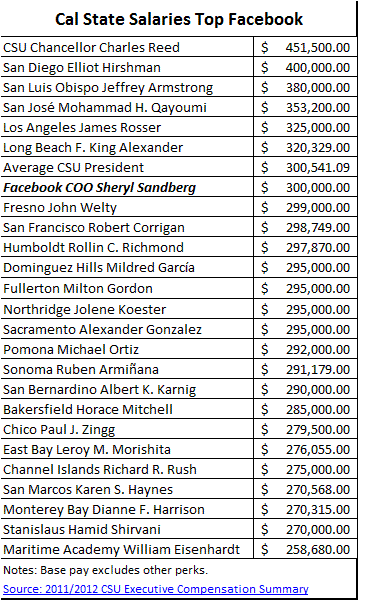Cal State Prez Salaries Top Facebook Exec
By JOHN HRABE
Facebook’s Chief Operating Officer Sheryl Sandberg is one of the country’s top executives. Under her tenure, the company has increased its user base tenfold—to more than 750 million users worldwide. That’s to be expected from someone with her pristine resume. She’s spent time at Google, the U.S. Treasury Department and Harvard Business School.
Thanks to Facebook’s Feb. 1 filing for an IPO, we now know exactly how much the company’s second-in-command earns for all her hard work: a respectable base salary of $300,000 per year. Not bad, but she could be doing a little bit better, if only she were in the public sector.
According to data from the Cal State University Chancellor’s office, the average base salary for Cal State presidents is a whopping $300,541. That means Sandberg, one of the private sector’s most accomplished executives, earns less money in base pay than the average base pay of the presidents of the state’s 23 Cal State campuses.
Just like Sandberg, these taxpayer-funded executives receive added perks and bonuses in addition to their base pay. Each Cal State president receives up to $60,000 per year in a housing allowance and $12,000 per year for a car allowance. The average presidential compensation package totals $372,000 per year. Who is responsible for this excessive compensation?
Cal State Trustees: The Public Sector’s Board of Directors
The Cal State University’s Board of Trustees, the equivalent of a corporate board of directors, sets the pay and compensation of university presidents. Earlier this year, the board explained its newly revised compensation policies. The board took up the matter only after public outcry following the trustees’ approval of a $400,000 annual salary for San Diego State University President Elliot Hirshman.
“The new compensation limits and more relevant tiered list of comparator institutions will give stakeholders a good benchmark of where presidential compensation will be set as we move forward,” Board Chairman Herbert Carter said in the press release, which listed the University of Southern California, Rutgers and Tufts University as comparator institutions.
State Sen. Leland Yee, D-San Francisco, who is arguably the legislature’s higher-education watchdog, isn’t buying into the Cal State’s phony executive compensation reforms. He told the San Francisco Chronicle in January that public institutions shouldn’t be cash cows for executives.
“While I am pleased to see CSU Board of Trustees finally recognize that their past executive compensation practices were completely unacceptable, their new policy just doesn’t go far enough,” Yee said in a recent press release. “Those making hundreds of thousands of dollars should not receive double-digit pay increases during bad budget times or when students are forced to foot the bill.”
I recently asked a spokeswoman for the Cal State system to justify the excessive compensation for Cal State executives.
“When you look at anybody’s salary, including presidents of public institutions, you need to look at the marketplace,” Claudia Keith, assistant vice chancellor of public affairs at Cal State wrote to me via email.
Which Marketplace Exactly?
Carter believes that the Cal State system should recruit and retain the best leaders. “Our continued goal is to recruit and compete for the best leadership possible, but also within articulated budget guidelines,” he said in a January press release.
Facebook executive Sandberg’s resume certainly qualifies her to lead a minuscule operation like a Cal State campus. After all, Cal State Los Angeles has fewer than 16,000 undergraduate students, or .002% of Facebook’s user base. Yet, Cal State LA’s chief executive, President James Rosser, earns $25,000 more per year than Sandberg.
Ultimately, students and taxpayers foot the bill for higher education’s highly compensated executives. Since 2004, the CSU Board of Trustees has increased tuition by more than 155 percent. In 2004, CSU undergraduate tuition was a bargain at $2,334 per year. This fall, incoming freshmen will pay just under $6,000 per academic year.
Hallmark of Bad Leadership
Business guru Warren Bennis, who heads the University of Southern California’s Leadership Institute, has written the book, “On Becoming a Leader.” His second lesson of leadership is to “accept responsibility and blame no one.” You’d expect the Cal State University system to be familiar with the book. Remember, they listed the University of Southern California as a comparator institution in their search for the “best leadership possible.”
“The board has had to raise tuition, not because of executive salaries, but because state funding for the CSU has been cut by a $1 billion over the past three years,” Keith said.
In other words, “Don’t blame us. It’s the Legislature’s fault.”
Related Articles
Race to the Tax Dollars
One of the reasons public education is so messed up in California is that matters aren’t controlled here by the
N.Y. Times continues tradition of inept California coverage
Oct. 30, 2012 By Chris Reed The New York Times’ history of poor coverage of California is extreme. It always
$578 million L.A. school
John Seiler: As a punctuation point to my recent article, “L.A. spends $30K per student,” the LAUSD is opening it’s



